SpringMVC源码剖析5:消息转换器HttpMessageConverter与@ResponseBody注解
转自 SpringMVC关于json、xml自动转换的原理研究[附带源码分析]
本系列文章首发于我的个人博客: https://h2pl.github.io/
欢迎阅览我的CSDN专栏:Spring源码解析 https://blog.csdn.net/column/details/21851.html
部分代码会放在我的的Github: https://github.com/h2pl/
目录
- 前言
- 现象
- 源码分析
- 实例讲解
- 关于配置
- 总结
- 参考资料
前言
SpringMVC是目前主流的Web MVC框架之一。
如果有同学对它不熟悉,那么请参考它的入门blog: http://www.cnblogs.com/fangjian0423/p/springMVC-introduction.html
现象
本文使用的demo基于maven,是根据入门blog的例子继续写下去的。
我们先来看一看对应的现象。 我们这里的配置文件 *-dispatcher.xml中的关键配置如下(其他常规的配置文件不在讲解,可参考本文一开始提到的入门blog):
(视图配置省略)
<mvc:resources location="/static/" mapping="/static/**"/> <mvc:annotation-driven/> <context:component-scan base-package="org.format.demo.controller"/>
pom中需要有以下依赖(Spring依赖及其他依赖不显示):
<dependency> <groupId>org.codehaus.jackson</groupId> jackson-core-asl <version>1.9.13</version> </dependency> <dependency> <groupId>org.codehaus.jackson</groupId> jackson-mapper-asl <version>1.9.13</version> </dependency>
这个依赖是json序列化的依赖。
ok。我们在Controller中添加一个method:

@RequestMapping(“/xmlOrJson”)
@ResponseBody public Map<String, Object> xmlOrJson() {
Map<String, Object> map = new HashMap<String, Object>();
map.put(“list”, employeeService.list()); return map;
}

直接访问地址:

我们看到,短短几行配置。使用@ResponseBody注解之后,Controller返回的对象 自动被转换成对应的json数据,在这里不得不感叹SpringMVC的强大。
我们好像也没看到具体的配置,唯一看到的就是*-dispatcher.xml中的一句配置: mvc:annotation-driven/ 。其实就是这个配置,导致了java对象自动转换成json对象的现象。
那么spring到底是如何实现java对象到json对象的自动转换的呢? 为什么转换成了json数据,如果想转换成xml数据,那该怎么办?
源码分析
本文使用的spring版本是4.0.2。
在讲解 mvc:annotation-driven/ 这个配置之前,我们先了解下Spring的消息转换机制。@ResponseBody这个注解就是使用消息转换机制,最终通过json的转换器转换成json数据的。
HttpMessageConverter接口就是Spring提供的http消息转换接口。有关这方面的知识大家可以参考”参考资料”中的 第二条链接 ,里面讲的很清楚。
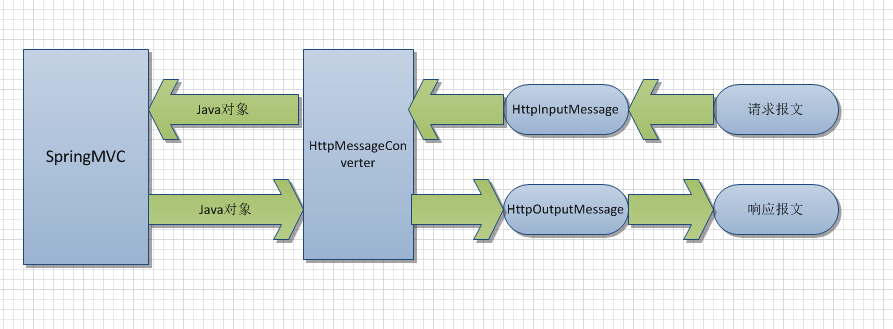
下面开始分析 mvc:annotation-driven/ 这句配置:
这句代码在spring中的解析类是:

在AnnotationDrivenBeanDefinitionParser源码的152行parse方法中:
分别实例化了RequestMappingHandlerMapping,ConfigurableWebBindingInitializer,RequestMappingHandlerAdapter等诸多类。
其中 RequestMappingHandlerMapping和RequestMappingHandlerAdapter 这两个类比较重要。
RequestMappingHandlerMapping处理请求映射的,处理@RequestMapping跟请求地址之间的关系。
RequestMappingHandlerAdapter是请求处理的适配器,也就是请求之后处理具体逻辑的执行,关系到哪个类的哪个方法以及转换器等工作,这个类是我们讲的重点,其中它的属性messageConverters是本文要讲的重点。

私有方法:getMessageConverters
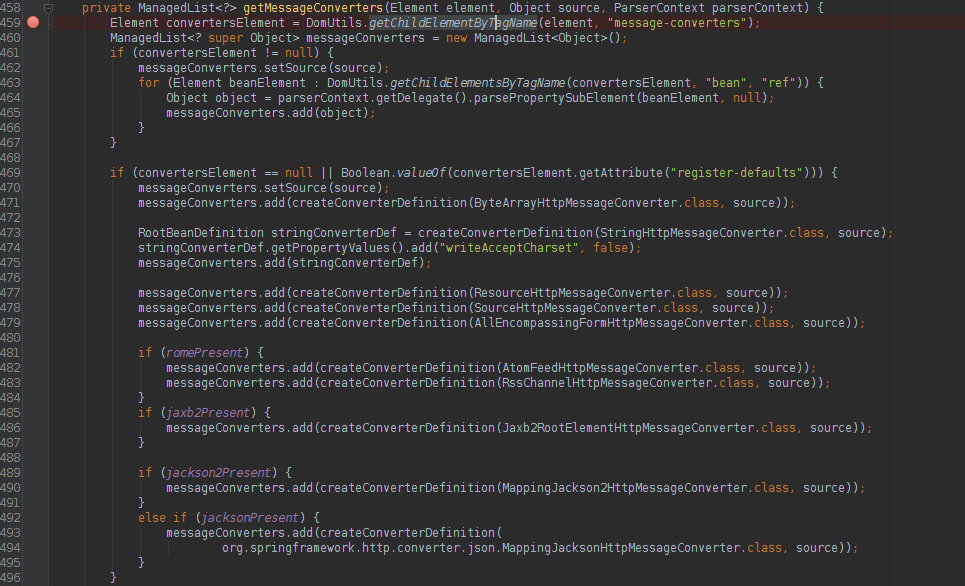
从代码中我们可以,RequestMappingHandlerAdapter设置messageConverters的逻辑:
1.如果 mvc:annotation-driven 节点有子节点message-converters,那么它的转换器属性messageConverters也由这些子节点组成。
message-converters的子节点配置如下:
<mvc:annotation-driven>
<mvc:message-converters>
<bean class="org.example.MyHttpMessageConverter"/>
<bean class="org.example.MyOtherHttpMessageConverter"/>
</mvc:message-converters>
</mvc:annotation-driven>
2.message-converters子节点不存在或它的属性register-defaults为true的话,加入其他的转换器:ByteArrayHttpMessageConverter、StringHttpMessageConverter、ResourceHttpMessageConverter等。
我们看到这么一段:

这些boolean属性是哪里来的呢,它们是AnnotationDrivenBeanDefinitionParser的静态变量。

其中ClassUtils中的isPresent方法如下:

看到这里,读者应该明白了为什么本文一开始在pom文件中需要加入对应的jackson依赖,为了让json转换器jackson成为默认转换器之一。
mvc:annotation-driven 的作用读者也明白了。
下面我们看如何通过消息转换器将java对象进行转换的。
RequestMappingHandlerAdapter在进行handle的时候,会委托给HandlerMethod(具体由子类ServletInvocableHandlerMethod处理)的invokeAndHandle方法进行处理,这个方法又转接给HandlerMethodReturnValueHandlerComposite处理。
HandlerMethodReturnValueHandlerComposite维护了一个HandlerMethodReturnValueHandler列表。 HandlerMethodReturnValueHandler是一个对返回值进行处理的策略接口,这个接口非常重要。关于这个接口的细节,请参考楼主的另外一篇博客: http://www.cnblogs.com/fangjian0423/p/springMVC-request-param-analysis.html 。然后找到对应的HandlerMethodReturnValueHandler对结果值进行处理。
最终找到RequestResponseBodyMethodProcessor这个Handler(由于使用了@ResponseBody注解)。
RequestResponseBodyMethodProcessor的supportsReturnType方法:

然后使用handleReturnValue方法进行处理:

我们看到,这里使用了转换器。
具体的转换方法:
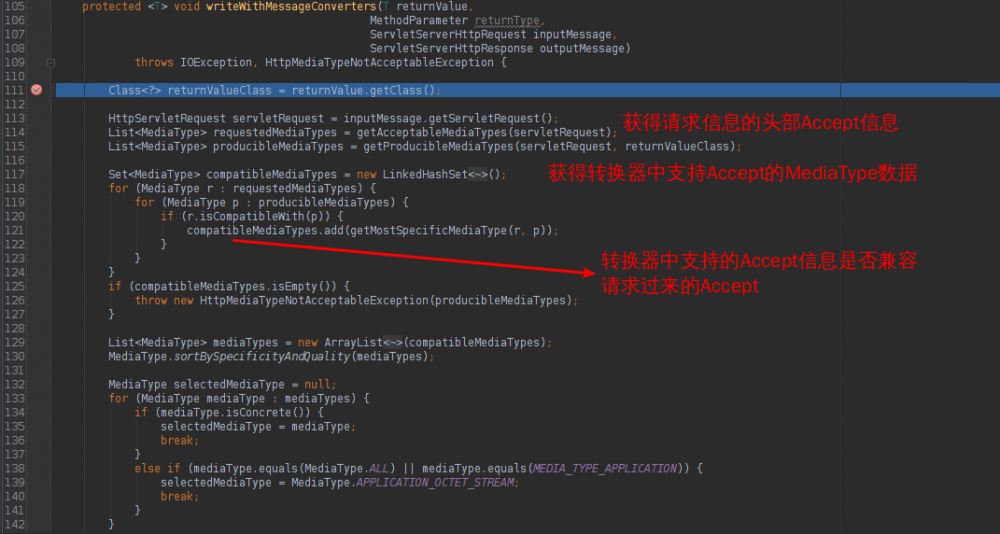

至于为何是请求头部的 Accept 数据,读者可以进去debug这个 getAcceptableMediaTypes 方法看看。 我就不罗嗦了~~~
ok。至此,我们走遍了所有的流程。
现在,回过头来看。为什么一开始的demo输出了json数据?
我们来分析吧。
由于我们只配置了 mvc:annotation-driven ,因此使用spring默认的那些转换器。

很明显,我们看到了2个xml和1个json转换器。 要看能不能转换,得看HttpMessageConverter接口的public boolean canWrite(Class<?> clazz, MediaType mediaType)方法是否返回true来决定的。
我们先分析SourceHttpMessageConverter:
它的canWrite方法被父类AbstractHttpMessageConverter重写了。



发现SUPPORTED_CLASSES中没有Map类(本文demo返回的是Map类),因此不支持。
下面看Jaxb2RootElementHttpMessageConverter:
这个类直接重写了canWrite方法。

需要有XmlRootElement注解。 很明显,Map类当然没有。
最终MappingJackson2HttpMessageConverter匹配,进行json转换。(为何匹配,请读者自行查看源码)
实例讲解
我们分析了转换器的转换过程之后,下面就通过实例来验证我们的结论吧。
首先,我们先把xml转换器实现。
之前已经分析,默认的转换器中是支持xml的。下面我们加上注解试试吧。
由于Map是jdk源码中的部分,因此我们用Employee来做demo。
因此,Controller加上一个方法:
@RequestMapping(“/xmlOrJsonSimple”)
@ResponseBody public Employee xmlOrJsonSimple() { return employeeService.getById(1);
}
实体中加上@XmlRootElement注解

结果如下:
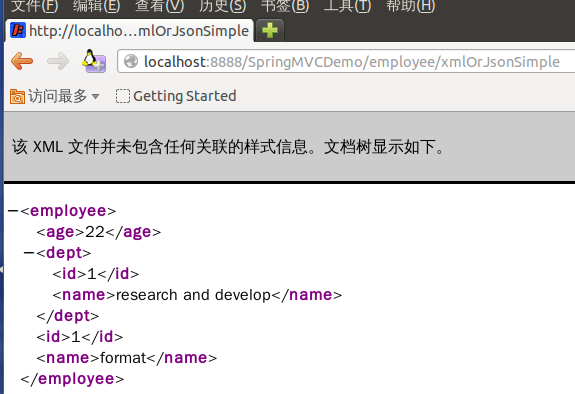
我们发现,解析成了xml。
这里为什么解析成xml,而不解析成json呢?
之前分析过,消息转换器是根据class和mediaType决定的。
我们使用firebug看到:
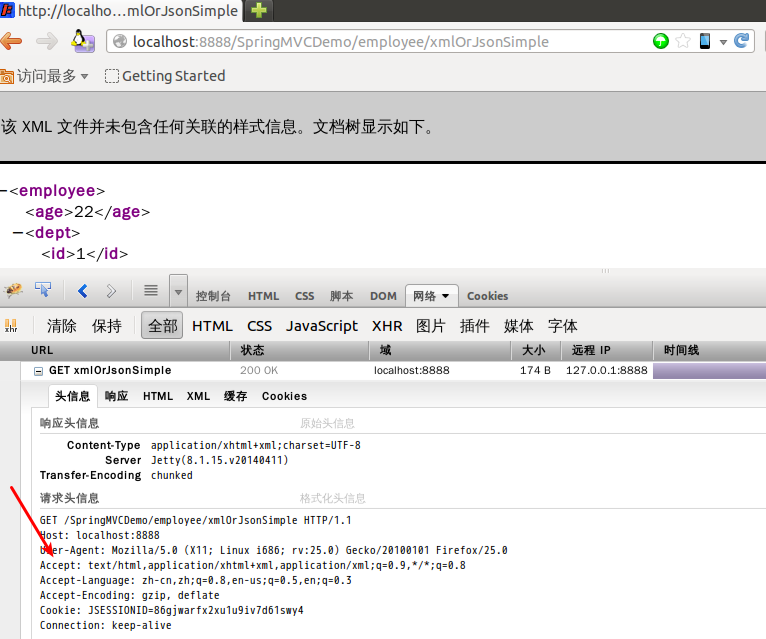
我们发现Accept有xml,没有json。因此解析成xml了。
我们再来验证,同一地址,HTTP头部不同Accept。看是否正确。

$.ajax({
url: "${request.contextPath}/employee/xmlOrJsonSimple",
success: function(res) {
console.log(res);
},
headers: { "Accept": "application/xml" }
});

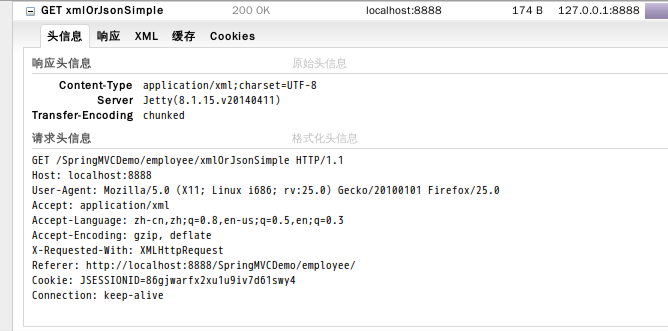

$.ajax({
url: "${request.contextPath}/employee/xmlOrJsonSimple",
success: function(res) {
console.log(res);
},
headers: { "Accept": "application/json" }
});

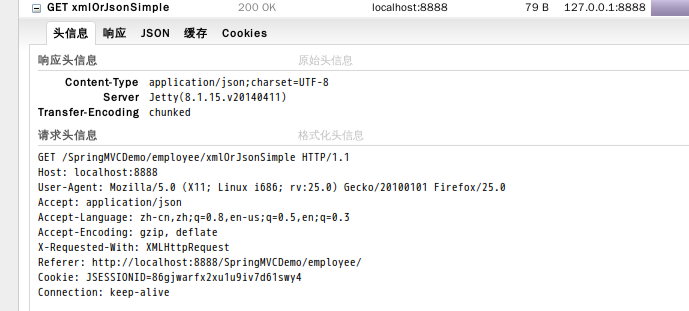
验证成功。
关于配置
如果不想使用 mvc:annotation-driven/ 中默认的RequestMappingHandlerAdapter的话,我们可以在重新定义这个bean,spring会覆盖掉默认的RequestMappingHandlerAdapter。
为何会覆盖,请参考楼主的另外一篇博客: http://www.cnblogs.com/fangjian0423/p/spring-Ordered-interface.html
<bean>
<property name="messageConverters">
<list>
<bean>
<bean>
<bean>
</bean>
</bean>
</bean>
</list>
</property>
</bean>`
或者如果只想换messageConverters的话。
<mvc:annotation-driven>
<mvc:message-converters>
<bean class="org.example.MyHttpMessageConverter"/>
<bean class="org.example.MyOtherHttpMessageConverter"/>
</mvc:message-converters>
</mvc:annotation-driven>
如果还想用其他converters的话。
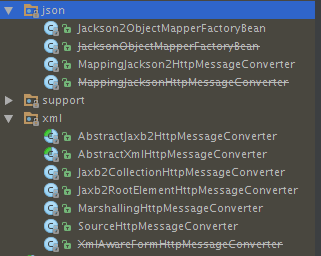
以上是spring-mvc jar包中的converters。
这里我们使用转换xml的MarshallingHttpMessageConverter。
这个converter里面使用了marshaller进行转换

我们这里使用XStreamMarshaller。
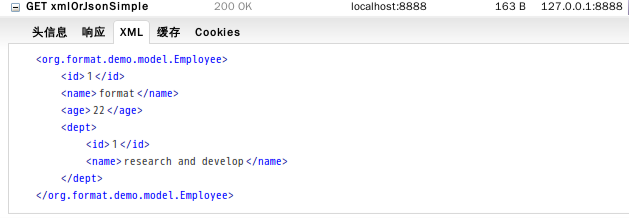
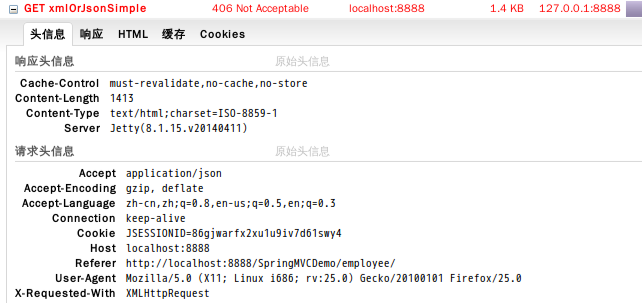
json没有转换器,返回406.
至于xml格式的问题,大家自行解决吧。 这里用的是XStream~。
使用这种方式,pom别忘记了加入xstream的依赖:
<dependency> <groupId>com.thoughtworks.xstream</groupId> xstream <version>1.4.7</version> </dependency>
总结
写了这么多,可能读者觉得有点罗嗦。 毕竟这也是自己的一些心得,希望都能说出来与读者共享。
刚接触SpringMVC的时候,发现这种自动转换机制很牛逼,但是一直没有研究它的原理,目前,算是了了一个小小心愿吧,SpringMVC还有很多内容,以后自己研究其他内容的时候还会与大家一起共享的。
文章难免会出现一些错误,希望读者们能指明出来。
参考资料
http://my.oschina.net/HeliosFly/blog/205343
http://my.oschina.net/lichhao/blog/172562
http://docs.spring.io/spring/docs/current/spring-framework-reference/html/mvc.html
详解RequestBody和@ResponseBody注解
概述 在SpringMVC中,可以使用@ RequestBody和@ResponseBody两个注解,分别完成请求报文到对象和对象到响应报文的转换,底层这种灵活的消息转换机制,就是Spring3.x中新引入的HttpMessageConverter即消息转换器机制。
#Http请求的抽象 还是回到请求-响应,也就是解析请求体,然后返回响应报文这个最基本的Http请求过程中来。我们知道,在servlet标准中,可以用javax.servlet.ServletRequest接口中的以下方法:
public ServletInputStream getInputStream() throws IOException;
来得到一个ServletInputStream。这个ServletInputStream中,可以读取到一个原始请求报文的所有内容。同样的,在javax.servlet.ServletResponse接口中,可以用以下方法:
public ServletOutputStream getOutputStream() throws IOException;
来得到一个ServletOutputStream,这个ServletOutputSteam,继承自java中的OutputStream,可以让你输出Http的响应报文内容。
让我们尝试着像SpringMVC的设计者一样来思考一下。我们知道,Http请求和响应报文本质上都是一串字符串,当请求报文来到java世界,它会被封装成为一个ServletInputStream的输入流,供我们读取报文。响应报文则是通过一个ServletOutputStream的输出流,来输出响应报文。
我们从流中,只能读取到原始的字符串报文,同样,我们往输出流中,也只能写原始的字符。而在java世界中,处理业务逻辑,都是以一个个有业务意义的 对象 为处理维度的,那么在报文到达SpringMVC和从SpringMVC出去,都存在一个字符串到java对象的阻抗问题。这一过程,不可能由开发者手工转换。我们知道,在Struts2中,采用了OGNL来应对这个问题,而在SpringMVC中,它是HttpMessageConverter机制。我们先来看两个接口。
#HttpInputMessage 这个类是SpringMVC内部对一次Http请求报文的抽象,在HttpMessageConverter的read()方法中,有一个HttpInputMessage的形参,它正是SpringMVC的消息转换器所作用的受体“请求消息”的内部抽象,消息转换器从“请求消息”中按照规则提取消息,转换为方法形参中声明的对象。
package org.springframework.http;
import java.io.IOException;
import java.io.InputStream;
public interface HttpInputMessage extends HttpMessage {
InputStream getBody() throws IOException;
}
#HttpOutputMessage 这个类是SpringMVC内部对一次Http响应报文的抽象,在HttpMessageConverter的write()方法中,有一个HttpOutputMessage的形参,它正是SpringMVC的消息转换器所作用的受体“响应消息”的内部抽象,消息转换器将“响应消息”按照一定的规则写到响应报文中。
package org.springframework.http;
import java.io.IOException;
import java.io.OutputStream;
public interface HttpOutputMessage extends HttpMessage {
OutputStream getBody() throws IOException;
}
#HttpMessageConverter 对消息转换器最高层次的接口抽象,描述了一个消息转换器的一般特征,我们可以从这个接口中定义的方法,来领悟Spring3.x的设计者对这一机制的思考过程。
package org.springframework.http.converter;
import java.io.IOException;
import java.util.List;
import org.springframework.http.HttpInputMessage;
import org.springframework.http.HttpOutputMessage;
import org.springframework.http.MediaType;
public interface HttpMessageConverter<T> {
boolean canRead(Class<?> clazz, MediaType mediaType);
boolean canWrite(Class<?> clazz, MediaType mediaType);
List<MediaType> getSupportedMediaTypes();
T read(Class<? extends T> clazz, HttpInputMessage inputMessage)
throws IOException, HttpMessageNotReadableException;
void write(T t, MediaType contentType, HttpOutputMessage outputMessage)
throws IOException, HttpMessageNotWritableException;
}
HttpMessageConverter接口的定义出现了成对的canRead(),read()和canWrite(),write()方法,MediaType是对请求的Media Type属性的封装。举个例子,当我们声明了下面这个处理方法。
@RequestMapping(value="/string", method=RequestMethod.POST)
public @ResponseBody String readString(@RequestBody String string) {
return "Read string '" + string + "'";
}
在SpringMVC进入readString方法前,会根据@RequestBody注解选择适当的HttpMessageConverter实现类来将请求参数解析到string变量中,具体来说是使用了StringHttpMessageConverter类,它的canRead()方法返回true,然后它的read()方法会从请求中读出请求参数,绑定到readString()方法的string变量中。
当SpringMVC执行readString方法后,由于返回值标识了@ResponseBody,SpringMVC将使用StringHttpMessageConverter的write()方法,将结果作为String值写入响应报文,当然,此时canWrite()方法返回true。
我们可以用下面的图,简单描述一下这个过程。
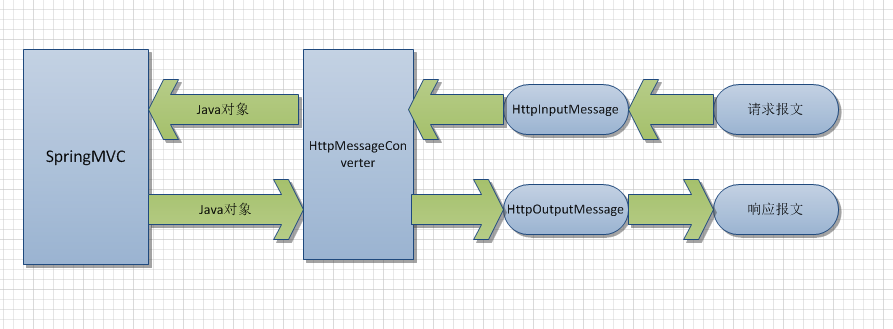
#RequestResponseBodyMethodProcessor 将上述过程集中描述的一个类是org.springframework.web.servlet.mvc.method.annotation.RequestResponseBodyMethodProcessor,这个类同时实现了HandlerMethodArgumentResolver和HandlerMethodReturnValueHandler两个接口。前者是将请求报文绑定到处理方法形参的策略接口,后者则是对处理方法返回值进行处理的策略接口。两个接口的源码如下:
package org.springframework.web.method.support;
import org.springframework.core.MethodParameter;
import org.springframework.web.bind.WebDataBinder;
import org.springframework.web.bind.support.WebDataBinderFactory;
import org.springframework.web.context.request.NativeWebRequest;
public interface HandlerMethodArgumentResolver {
boolean supportsParameter(MethodParameter parameter);
Object resolveArgument(MethodParameter parameter,
ModelAndViewContainer mavContainer,
NativeWebRequest webRequest,
WebDataBinderFactory binderFactory) throws Exception;
}
package org.springframework.web.method.support;
import org.springframework.core.MethodParameter;
import org.springframework.web.context.request.NativeWebRequest;
public interface HandlerMethodReturnValueHandler {
boolean supportsReturnType(MethodParameter returnType);
void handleReturnValue(Object returnValue,
MethodParameter returnType,
ModelAndViewContainer mavContainer,
NativeWebRequest webRequest) throws Exception;
}
RequestResponseBodyMethodProcessor这个类,同时充当了方法参数解析和返回值处理两种角色。我们从它的源码中,可以找到上面两个接口的方法实现。
对HandlerMethodArgumentResolver接口的实现:
public boolean supportsParameter(MethodParameter parameter) {
return parameter.hasParameterAnnotation(RequestBody.class);
}
public Object resolveArgument(MethodParameter parameter, ModelAndViewContainer mavContainer,
NativeWebRequest webRequest, WebDataBinderFactory binderFactory) throws Exception {
Object argument = readWithMessageConverters(webRequest, parameter, parameter.getGenericParameterType());
String name = Conventions.getVariableNameForParameter(parameter);
WebDataBinder binder = binderFactory.createBinder(webRequest, argument, name);
if (argument != null) {
validate(binder, parameter);
}
mavContainer.addAttribute(BindingResult.MODEL_KEY_PREFIX + name, binder.getBindingResult());
return argument;
}
对HandlerMethodReturnValueHandler接口的实现
public boolean supportsReturnType(MethodParameter returnType) {
return returnType.getMethodAnnotation(ResponseBody.class) != null;
}
public void handleReturnValue(Object returnValue, MethodParameter returnType,
ModelAndViewContainer mavContainer, NativeWebRequest webRequest)
throws IOException, HttpMediaTypeNotAcceptableException {
mavContainer.setRequestHandled(true);
if (returnValue != null) {
writeWithMessageConverters(returnValue, returnType, webRequest);
}
}
看完上面的代码,整个HttpMessageConverter消息转换的脉络已经非常清晰。因为两个接口的实现,分别是以是否有@RequestBody和@ResponseBody为条件,然后分别调用HttpMessageConverter来进行消息的读写。
如果你想问,怎么样跟踪到RequestResponseBodyMethodProcessor中,请你按照前面几篇博文的思路,然后到这里 spring-mvc-showcase 下载源码回来,对其中HttpMessageConverter相关的例子进行debug,只要你肯下功夫,相信你一定会有属于自己的收获的。
#思考 张小龙在谈微信的本质时候说:“微信只是个平台,消息在其中流转”。在我们对SpringMVC源码分析的过程中,我们可以从HttpMessageConverter机制中领悟到类似的道理。在SpringMVC的设计者眼中,一次请求报文和一次响应报文,分别被抽象为一个请求消息HttpInputMessage和一个响应消息HttpOutputMessage。
处理请求时,由合适的消息转换器将请求报文绑定为方法中的形参对象,在这里,同一个对象就有可能出现多种不同的消息形式,比如json和xml。同样,当响应请求时,方法的返回值也同样可能被返回为不同的消息形式,比如json和xml。
在SpringMVC中,针对不同的消息形式,我们有不同的HttpMessageConverter实现类来处理各种消息形式。但是,只要这些消息所蕴含的“有效信息”是一致的,那么各种不同的消息转换器,都会生成同样的转换结果。至于各种消息间解析细节的不同,就被屏蔽在不同的HttpMessageConverter实现类中了。
- 本文标签: BeanDefinition UI id 解析 root 参数 ACE js ORM GitHub 适配器 XML pom example message 配置 希望 HTML web SpringMVC 博客 https bean SDN HashMap json maven Ajax IOS map Struts2 App java list http git Service 数据 本质 实例 tab 总结 下载 功夫 IO CTO spring value core servlet Property 开发者 bug parse 源码 开发 文章 cat mapper 代码 目录 key src
- 版权声明: 本文为互联网转载文章,出处已在文章中说明(部分除外)。如果侵权,请联系本站长删除,谢谢。
- 本文海报: 生成海报一 生成海报二











![[HBLOG]公众号](https://www.liuhaihua.cn/img/qrcode_gzh.jpg)

